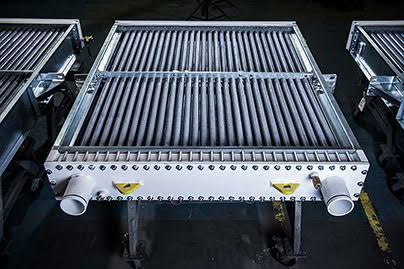Hydro Power Plant Dummy Load Heat Exchangers:
Overview:
The most common type of hydro power plant dummy load Heat Exchangers are uses a dam on a river to store water in a reservoir. Water released from the reservoir flows through a turbine, spinning it, which in turn activates a generator to produce electricity. But hydro power plant doesn’t necessarily require a large dam. Some hydroelectric power plants just use a small canal to channel the river water through a turbine.
Process:
Hydro power plant dummy load generating systems are hydro systems that provide 10-100 Kilo-watts of power. (For comparison of size a standard freezer is rated at 0.5 KW of power with a starting up power of 2.5 KW). APACE hydro power plant dummy load generating systems provides electricity at 240 Volts so that equipment is readily available locally for income generating and educational projects.
Image:

Features:
- The unit is designed in mobile for easy use during generator load testing, electrical and marine load testing.
- Use low heat created heating element. In order to minimize the heating element to create so much heat, we design the higher voltage for heating element than what is rated voltage to which the total weight is sacrifice. However, this unit can be used continuously even inside assembly plant because the said heating element is U type element with cooling fins.
- The series of models provide resistive load from 0 to maximum load, convenient to use and easy to operate with step load ban variable adjustment.
- The digital meter displays the line voltage, line ampere, frequency, power factor(optional) and power measurements.
- Digital metering
- Large load capacity
Advantages:
- Compact tubular heat exchanger
- Long running times due to turbulent flow
- Very low maintenance costs, minimum spares requirement
- Higher heat transfer coefficient (2-3 times) results in reduction in heat exchanger area up to 50%
- Fouling is minimised due to turbulence created by eddies at the periphery or tube wall
- High response to CIP
- Wide choice of MOC
Applications:
- Communication Cabinet
- Electric control cabinet
- Charging stations
- Food industry: Juices, beverages, sauces, dairy, deserts, fruit puree, whole fruit, catering, convenient food, pasteurization.
- Industry: Chemical, petrochemical, polymers, heating, cooling, condensation, crystallization, evaporation, energy recovery.
6.Environmental: Waste water, environmental waste concentration, evaporation, sludge, pasteurization. - Bio-energy: Bio ethanol, biodiesel, biogas, cogeneration

